Room 17
This room, which occupies a partitioned space in Room 16, contains precious metal and ivory artefacts that come mostly from the churches of Perugia. The most important of them, as described below, came from or were associated with San Domenico.
Gilded silver chalice and paten (ca. 1304)
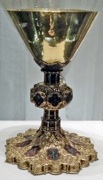
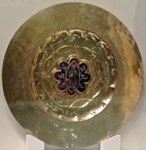
It seems that Pope Benedict XI had these precious items with him when he died at Perugia. He had probably intended to give them to the friars of San Domenico since the enamels of saints around the base of the chalice include SS Herculanus and Lawrence, two of the patron saints of Perugia.
Both the chalice and the paten, which has an enamel of the Ascension at its centre, are mentioned in the two oldest inventories from San Domenico, respectively dated 1417 and 1430. The chalice continued to be recorded there until 1863, when it was moved to the gallery. The paten was among a cache of precious objects that was discovered under the floor of the choir in 1954, at which point it was reunited with the chalice in the gallery.
The design of the chalice is similar to the chalice (ca. 1290) by the Sienese Guccio di Mannaia that Pope Nicholas IV gave to the Franciscans at San Francesco, Assisi (which is now in the Treasury there). The artist responsible for the San Domenico chalice and patens seems to have been a follower of another Sienese, Pace di Valentino.
Patens (early 14th century)
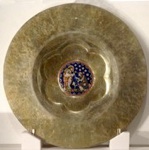
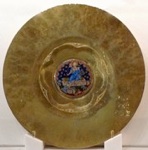
These two patens were rediscovered under the floor of the choir of San Domenico in 1954, when they were moved to the gallery:
-
✴the enamel at the centre of the one on the left depicts St James and a pilgrim; and
-
✴the enamel at the centre of the other one depicts the Resurrection.
Each of them had been recorded, along with an accompanying chalice, in the sacristy in the inventories of 1430 and 1458. Both chalices were subsequently lost, but that corresponding to the first paten had been inscribed with the signatures of the Sienese Tondino di Guerrino and Andrea Riguardi. It is likely that the second chalice and both patens also came from this workshop.
Gilded silver paten (mid 14th century)
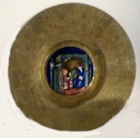
Gilded silver chalice and paten (late 14th century)

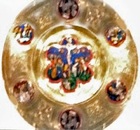
These objects, which were recorded in the sacristy of San Domenico in the inventories from 1417 onwards, remained there until 1863, when they were moved to gallery. The chalice is inscribed with the signature of Cataluzio di Pietro da Todi ("Catalutius Petri de Tuderto me fecit").
Reliquary of St Anne (late 14th century)
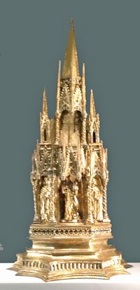
The niche in the upper register once contained two of the fingers of St Anne, the mother of the Virgin, but these were apparently stolen in 1609. The niches in the lower register contain statues of the Madonna and Child and of SS Dominic and Thomas Aquinas.
Tabernacle for the Reliquary of St Juliana (ca. 1376)


Lower part of reliquary (1376) Upper part of reliquary (1852)
This gilded copper tabernacle from Santa Giuliana, which was probably commissioned from a Sienese workshop, originally contained a reliquary that in turn contained a piece of the skull of St Juliana.
The relics of this saint had been translated from Cuma to Naples in 1207, and this fragment subsequently passed into the possession of the friars of San Domenico. They enclosed it in a reliquary bust (ca. 1376) of the head of St Juliana, which was inscribed with the additional information that it had been made in Rome by Master William.
In 1376, Bishop Andrea Bontempi persuaded the friars to give the relic and its reliquary to the nuns of what was then the Monastero di Santa Elisabetta, where his sister, Gabriella was the Abbess. The nuns changed the dedication of their nunnery to Santa Giuliana at this time. They also commissioned this tabernacle to enclose the reliquary: the inscription records that the friars had made a gift of the reliquary that it housed “of their own free will and with honour”.
An inscription on the upper part of the tabernacle records that Abbess Ermelinda Montesperelli commissioned it as a replacement for the upper part of the original in 1852: the gallery attribute this part of the reliquary to Nicola Benvenuti and Diomede Martelli. The lower part of the tabernacle seems to have been heavily restored at this point.
The nuns removed the reliquary from the tabernacle in the Napoleonic period so that both could be hidden. The nuns took these precious possessions with them when they moved from Santa Giuliana to Santa Maria di Monteluce in ca. 1862.
-
✴The tabernacle was subsequently moved to the gallery, and was included in an exhibition held in 1907.
-
✴The reliquary that it originally housed appeared on the market in 1933 and subsequently found was bought by the Metropolitan Museum, New York in 1961.
Galleria Nazionale: Sala Podiani and Sala Conferenze Rooms 1-3 Room 4
Rooms 5-6 Rooms 7-10 Rooms 11-16 Room 17 Rooms 18-20 Cappella dei Priori
Rooms 22-28 Rooms 29-32 Rooms 33-40 Deposit
Return to Museums of Perugia.
Return to Walk I.



